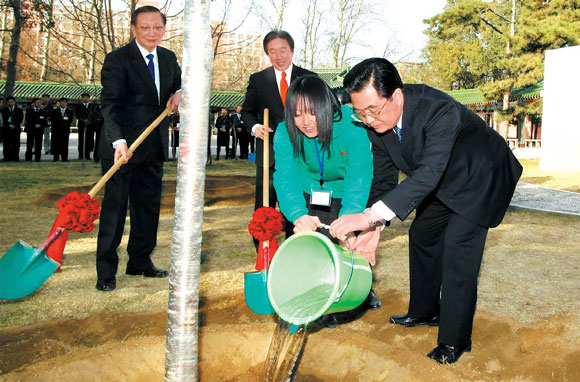
President Hu Jintao plants a tree at the opening ceremony of China-Japan Friendly Exchange Year in Beijing. Xinhua
Chinese and Japanese calligraphy students received a lesson they will never forget. On his first official function after being elected president of the world's most populous nation, Hu Jintao attended the opening ceremony of the China-Japan Friendly Exchange Year.
Later he visited a group of students all busy practicing their calligraphy skills. They were so focused on their brushstrokes that few were aware a very important guest was approaching.
Hu looked at their messages of hope and smiled. To their surprise, the president picked up a brush, dipped it in ink and wrote: "Strive for friendship of generations with the strength of all the youth."
The students from Ritsumeikan University in Kyoto and the China Foreign Affairs University were filled with wonder and delight.
Hu has a long history working with young people. More than 20 years ago, Hu was the Chairman of the All-China Youth Federation, and received 3,000 Japanese young people in Beijing. This year, Hu expects many more Japanese youths to visit.
"I always enjoy spending time with the young people," Hu says.
"It's not only because I used to be engaged in the work related to them but also because they are the future of the world."
He says friendship between young people is the key to ensuring a brighter future for China-Japan friendship in the generations to come.
Hu's warm words, at the opening ceremony on Saturday at Renmin University in Beijing, aroused thunderous applause from the 2,008 youngsters - 1,008 from China and 1,000 from Japan.
Daiki Nakae, 17, with Minakuchi High School, was excited to meet President Hu.
"I shook hands with the Chinese president and was deeply impressed. He is such a brilliant and amiable man with a good smile on the face," she says.
Yotaro Kobayashi, chief Japanese member of the new 21st Century Committee for China-Japan Friendship says Hu's participation at the ceremony, despite his busy schedule at the ongoing National People's Congress, reveals the significance the president places on young people.
As well as the calligraphy class, Hu took part in a tea ceremony and planted a Chinese magnolia tree and Japanese cherry tree with his Japanese friends.
The Exchange Year is the result of a meeting by Premier Wen Jiabao and his Japanese counterpart Yasuo Fukuda in Singapore last November.
Hu Chunhua, the chairman of the organizing committee of the Exchange Year, says the young people of the two countries share their cultures and knowledge in an effort to deepen understanding and enhance the friendship.

Chinese and Japanese students show their calligraphy skills at a communication event in Beijing.
Hiroaki Watanabe, a second-year economics major, says he felt proud to receive President Hu's praise on his work with a Chinese girl. Their calligraphy read: "gong dao zi ran cheng", or "constant efforts yield sure success".
Watanabe's co-writer Zhu Jing explains the work is a gift for China-Japan friendship.
"I believe you will definitely succeed after continuous work," President Hu told them.
Nozomi Ogawa, 19, said all of the 70 members of the calligraphy association of Ritsumeikan University have developed a strong interest in Chinese characters and the culture behind them.
Ogawa, who visited East China's Shandong province in 2005 to see inscriptions on stone tablets, is familiar with China and said Chinese youth had no "notable differences" from her Japanese peers.
"When I walked into Chinese universities, watching Chinese students roaming, talking and playing basketball, I felt they are just the same as the Japanese students, in terms of skin color and the way they are dressed," she says.
"But I found them more diligent than the Japanese. My Chinese partner has learned Japanese for merely two years and speaks quite well. I don't think average Chinese majors in Japanese universities can reach the level after two years' efforts."
Tsuyoshi Kitazawa, 40, a retired Japanese soccer player, first visited Beijing in 1990 to play in a soccer match. He was overwhelmed by the changes.
"Beijing has changed dramatically in the past 18 years and its young generation looks modern. I am sure that the differences between Japanese and Chinese youth will diminish and they will get much closer in the future," he says.
Over the past week, the Japanese visitors, including parliamentarians, government officials, businessmen and journalists, toured various Chinese cities.
In Shanghai, a group of more than 90 Japanese college students arrived at The East China Normal University. The students were surprised to find so many shared common interests.
"Visiting here changed my outlook. I found Chinese students are quite open-minded and very easy to communicate with," says Ito Eriko of the Kyoto Women's University.
In Chongqing, the Japanese delegation paid a visit to an exhibition hall on the War of Resistance against Japanese Aggression showing records of the air raids. Japanese and Chinese students expressed the wish of "no more wars".
Iino Tomoko, a college freshman, says her trip to Hangzhou, in Zhejiang province, changed her outlook forever. "Hangzhou is a beautiful city and people here are warm and friendly," she says.
Tomoko also wanted to learn more about China's view on environmental pollution and global warming, hoping that Japan and China will strengthen cooperation on environmental protection and energy conservation.
Japanese Vice-Minister of Foreign Affairs Osamu Uno led the Japanese delegation, which also visited Dalian, Shenyang, Guangzhou and other Chinese cities during their weeklong visit in China.
(China Daily March 17, 2008)